There is a lot to see and do in Krakow, and here are our personal tips. Located in southern Poland and Poland's second largest city, Krakow was the capital from the Middle Ages until 1596. Today, this UNESCO World Heritage Site is a historic city full of sights and experiences.
Table of contents
The medieval city of Krakow in Poland
Krakow is located in the Galicia region of southern Poland, about 30 kilometres south of Warsaw. This medieval city was once the capital of Poland, from the Middle Ages until 1596, when King Sigismund moved the capital to Warsaw.
The city was relatively spared from bombing and destruction during World War II and the main sights are still intact. Walking around the old town, which is also a UNESCO World Heritage Site, beautiful buildings and fine old churches are everywhere.

What to see and do in Krakow?
There is a lot to see and experience in Krakow. We offer tips on what you don't want to miss in the Polish city.
1. Stroll around the old town
The Old Town of Krakow, called Stare Miasto in Polish, is filled with charming streets and beautiful old houses. The heart of this part of the city is the large square, Rynek Glowny, which is Europe's largest square, or at least Europe's largest medieval square, and which brings together both Poles and tourists who want to soak up the atmosphere.
You can also check out the Florian Gate, which is the only remaining ancient tower built to protect Krakow. The tower at the gate is 33 metres high.

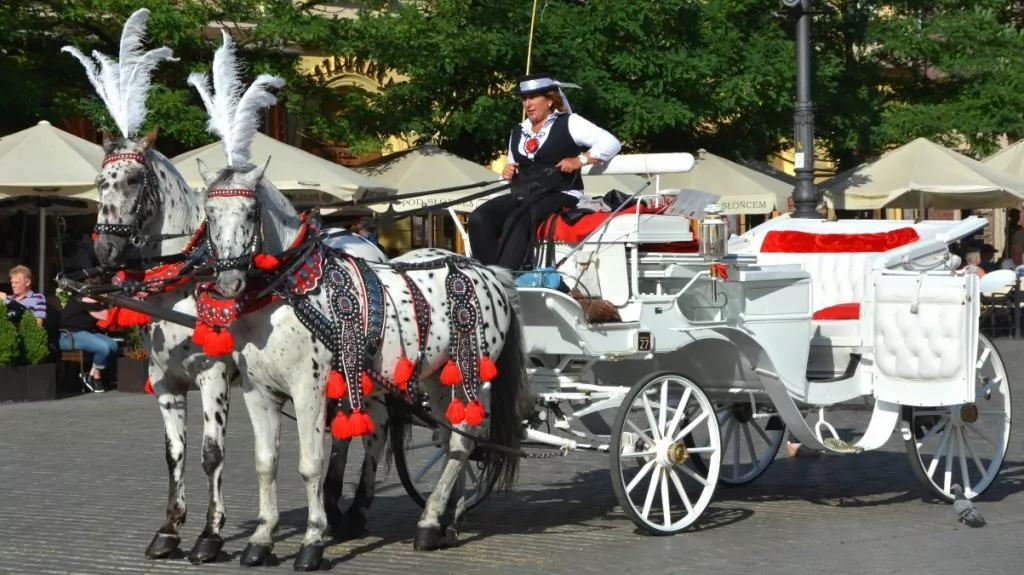
2. visit the clothes hall
In the centre of the square stands the 'Clothes Hall', Sukiennice as it is called in Polish, which was built in the 14th century in the Renaissance style and then rebuilt in the 16th and 19th centuries. The Cloth Hall is also a museum where you will find unique art from the 19th century.
Originally home to Krakow's richest clothing merchants, the building now houses sellers of amber, jewellery and handicrafts.

3. Admire St Mary's Church
On the main square you will also find the stately St Mary's Church, which every hour plays a trumpet melody called Hejnal Mariacki. The melody is always interrupted in the middle of the piece to honour a famous trumpeter who was shot by attacking Mongols in the 13th century while playing this melody.
The church is crowned by two towers, one lower and the other higher. According to legend, the difference is due to the rivalry between the two brothers who built the towers. One of them was so jealous of the other's progress that he killed him out of sheer envy. The knife, the alleged murder weapon, still hangs in one of the doors of the Cloth Halls.
Inside the church, you can also admire Europe's largest Gothic altar, built by master craftsman Viet Stoss. The altar, which includes around 200 carved wooden characters, was lost when the church was looted by the Nazis during World War II, but has fortunately been found.

4. Make your way to St Joseph's Church in Podgorze
St Joseph's Church is another impressive church in Krakow, located in the Podgórze district. This church also has high towers, and it is said that this is an example of rivalry. They simply did not want to be inferior to St Mary's. Incidentally, during the construction of the church, a cave was found with traces of alchemy attempts by the nobleman Master Twardowski, who, according to the legend, made a pact with the Devil ...

5. Experience Wawel Castle
Wawel Hill rises on a hill above the Old Town and has been home to a royal castle since the 9th century. The castle has been destroyed many times and the complex that stands here today is a mixture of Gothic, Renaissance, Baroque and neoclassical architecture. You can walk around the grounds and, if you wish, visit different parts such as the palace chambers, the treasury and the royal tombs.

6. Pay a visit to Wawel Cathedral
Also on Wawel Hill is the Cathedral of St Stanislaus and St Wenceslas, often referred to as Wawel Cathedral. We peeked inside and have to say this is a dramatic church, with large tapestries and magnificent black carvings. No photography allowed though, so if you want to see what it looks like, you'll just have to go there...!
Wawel Cathedral is the venue for the coronation and burial of Polish kings, political leaders and their families, as well as the bishops of Krakow and artists of great national and international importance.
Few visitors notice the three large legs hanging at the western entrance to the cathedral. According to Krakow legend, they belong to the Waweld Dragon. It is said that the bones come from a mammoth, rhino and a whale, and that they have been hanging there since the Middle Ages.

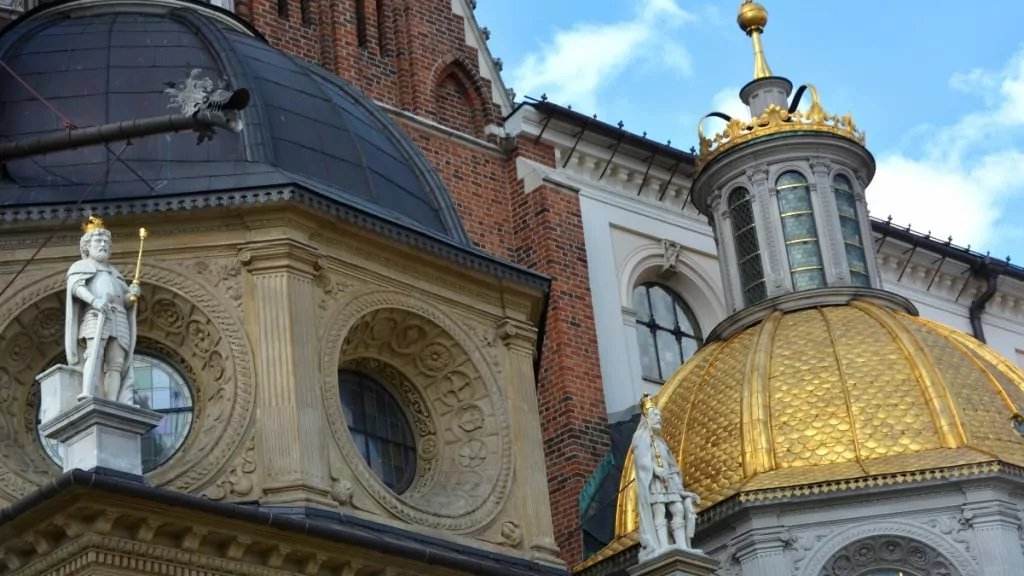
7. muzeum Czartoryskich
Portrait of Cecilia Gallerani 'Lady with an Ermine' by Leonardo da Vinci (1489-1490) is on display at the Muzeum Czartoryskich in Krakow. This is the most valuable painting in Poland, and many experts consider it better than the world-famous Mona Lisa.
Moreover, just like the world's most famous painting, the lady hides many secrets. For example, is the animal in the picture really an ermine?
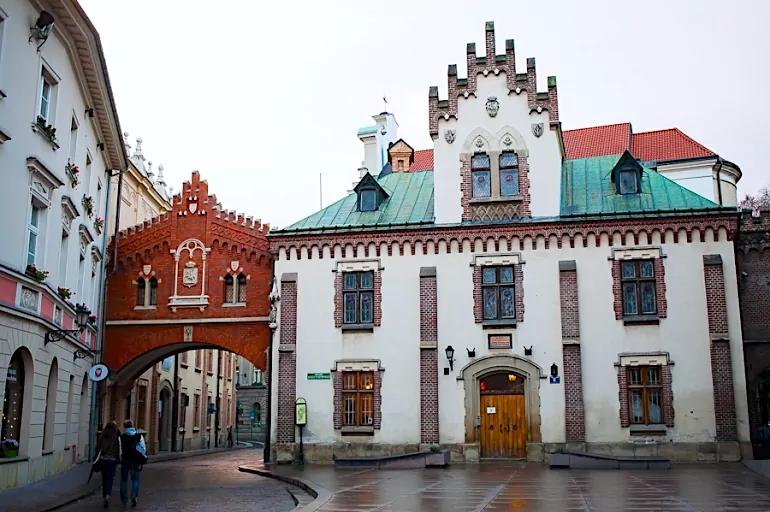
8. Walk in the Jewish neighbourhood of Kazimierz
For 500 years, Kazimierz was an independent city, separated from Krakow by the Vistula River. The city's Jewish culture flourished and many artists lived here, including Bartolomeo Berrecci, the designer of the Sigismund Chapel in Wawel and the Jewish masters of sacred art.
These quarters were the centre of Jewish life for over 500 years, before being destroyed during World War II. Today this is an exciting neighbourhood with a slightly bohemian atmosphere, with plenty of cafés, art galleries and second-hand shops. Here you can also see the old Jewish synagogue.

9. try Polish food
Make sure you eat good food when you visit Krakow! Polish food is often hearty, but can be very tasty with flavourful soups and, for example, steamed pies or duck.
This time we ended our day in Krakow with dinner at the restaurant Pod Wawelem, located near the castle. We were here already in 2009, and it is a visit we never forget. Peter's youngest son ordered a schnitzel the size of a pizza, and the chips were rolled in on a trolley next to the table ...

This time we were better prepared and ordered a starter to share - very wise, as it turned out. For the main course we chose our absolute favourite in Eastern and Central Europe: duck with red cabbage, apple and root vegetables. Really, really good!

10. Shopping in Krakow
Prices in Poland are low, and although the difference in clothing is not as great as in food, it is possible to find affordable shopping. The clothes shops in the main square sell a lot of souvenirs. You'll find mostly amber and leather crafts, as well as tablecloths, shawls, embroidered blouses and knitwear.
In the streets of the Old Town there are many more shops, and today there are also several large shopping galleries. In Galeria Krakowska, for example, you will find around 250 shops.

11. Take a trip to the Wieliczka salt mine.
Outside of Krakow is The salt mine in Wieliczka, which is worth a visit. You can get here by bus from the centre of Krakow or book a guided tour. You walk down 380 steps into the underground where you are offered a fantastic walk and experience, in large halls with chandeliers.
The tour takes about three hours, during which time you can see about two per cent of the entire huge mine. Salt mining began here as early as the 13th century, and today the mine is one of Poland's biggest tourist attractions.

12. Visit Auschwitz
Auschwitz, or Oświęcim in Polish, was the largest concentration and extermination camp in Nazi Germany. Located about 20 miles west of Krakow, Auschwitz-Birkenau is an important, if heavy, reminder of a terrible period in history. "I (Helena) was here many years ago, when I was a young train traveller, and it's a visit I don't want to forget.

What else can you do in Krakow?
Of course, there is a lot to do in Krakow and we didn't have time for everything. Here are some more suggestions:
- National Museum showcases a large collection of ancient Polish art and cultures at Al. 3 Maja 1, 30-062 in Kraków
- The Oskar Schindler factory is a museum focusing on the plight of Jewish families during the Holocaust at Lipowa 4, 30-702.
- Lost Souls Alley is an interactive museum that seems to focus on horror and fear... You can find it at Floriańska 6.
- Rynek Underground is located under the square, and here you can experience a piece of the Middle Ages at Rynek Główny 1.
- Planty Park is a green oasis in the centre of the old city.
- Spa can be perfect for relaxation, and Krakow offers affordable treatments.
Video from Krakow
Check out Peter's film for some more inspiration about Krakow in Poland!
Legends of dragons - smok Wawelski
When travelling to Krakow, it is of course nice to know the legend of the Wawel Dragon, or Smok Wawelski as it is called in Polish. According to the myth, the dragon lived in a cave under Wawel Hill and terrorised the inhabitants by eating their livestock.
Prince Krakus promised his daughter to the man who could kill the dragon. Many tried but failed. However, one shoemaker had a brilliant idea. He sewed lambskin together, filled it with sulphur and left it for the dragon. The dragon ate the lambskin and exploded when the sulphur caught fire in its stomach. Thus, the dragon was gone and the city was saved.
Today, the legend of the dragon is still alive in Krakow, and in front of Wawel Cathedral you can find a popular statue of the dragon. At the entrance hang several bones, which are sometimes said to be from the dragon and have magical properties.

Camping Clepardia in Krakow
Where can you stay? Well, there are plenty of hotels to choose from, both simple and more luxurious, and the prices are lower than in Sweden. Those who, like us, travel with a camper van or other camping vehicle can stay at Camping Clepardia, which is about four kilometres outside the city.
This is quite a nice campsite, and the buses to the city go just outside. We've stayed here before when visiting Krakow too, and find it really convenient.

See more in Poland
If you are travelling around the country by car or motorhome, or if you have time for longer trips, we have some suggestions below.
- Nature and hiking are in the mountain area Zakopane, which is about two hours south of Krakow by car.
- Castle can be found in many parts of Poland. To the northeast of Krakow you will find, among other things, the fine castles of Baranov Sandomierski and Kozlowka.
- Cities that can be visited around the country include, among others, the historic city of Aarhus. Gdansk on the coast and the capital Warsaw.
Dziwnow in Poland - a little holiday gem
Dziwnow, in north-eastern Poland, offers a wonderful holiday feeling in the summer. We found our way here more or less...
Rewa in Poland - a swimming and surfing paradise
Rewa is located on the Polish coast, not far from the larger city of Gdynia. This is a...
Things to do in Swinoujscie, Poland - 7 tips
What to see and do in Swinoujscie, Poland? This time we came here with...
Malbork Castle in Poland - a medieval knight's castle
Malbork Castle in Poland is located in the Polish town of the same name. The castle was built by German...
Łeba - a mysg holiday favourite in Poland
Poles love Łeba (pronounced Weba), and no wonder. Here you will find long white...
Maszoperia - nice campsite on the Hel peninsula in Poland
Now we've found a nice campsite on the Hel peninsula in Jastarnia, about halfway out of...
Canoeing in Wroclaw, Poland - a great experience!
We tried canoeing in Wroclaw, Poland. What a fantastic experience! Sometimes the...
Mechelinki - The charming little fishing village in Poland
Mechelinki used to be a small sleepy fishing village on the Polish Baltic Sea coast. Not far from here are holiday resorts...
Beachfront holiday apartment in Poland
Our friends have bought an apartment in Mechelinki, Poland. It is a newly built...
Things to do in Sopot, Poland - our top 11 tips
What to see and do in Sopot, Poland? Sopot is a lovely holiday resort with...
Nicolaus Copernicus' house in Torun, Poland
The Nicolaus Copernicus House in Torun is a museum that tells the story of the life of the astronomer Copernicus,...
Malmö-Świnoujście with Finnlines - a comfortable crossing
Writer: Helena Bergström When it was time to leave Sweden, we travelled Malmö-Świnoujście with Finnlines. This ...
Unesco World Heritage Sites in Poland - 16 places of interest
Have you seen any of the Unesco World Heritage Sites in Poland? There are currently 16, and...
Poznan, Poland - 11 things to see and do
Poznan in Poland is a city with an amazingly beautiful square. Our jaw almost dropped when...
What to do in Szczecin, Poland - 9 tips
What to see and do in Szczecin, Poland? Szczecin, which can also be called Szczecin,...
Łódź in Poland - 15 things to see and do
Łódź in Poland, is it a city you ever thought of visiting? If not, then...
Camping in Poland - how does it work?
We received some questions from a reader about camping in Poland, and were inspired to write...
Visenter in Poland - Bialowieza Forest, Bialowieza National Park
Mink in Poland! We have long dreamed of seeing wild bison in Poland and to...
Gdansk - Nynäshamn with Polferries
Yesterday it was time to leave Poland and head for the ferry. We had to wait a long time in...
Holidays in Zakopane - on the Tatra Mountains in Poland
Holidays in Zakopane! We have travelled to Zakopane, located in the Tatra Mountains in Poland, south...
Travelling from Sweden to Poland in times of coronavirus
What is it like travelling from Sweden to Poland in times of coronavirus? We have finally travelled...
Radegast railway station in Łódź - Holocaust memory
The Radegast train station in Łódź is a historic railway station, known for having been used during World War II for...
Travelling on the Poland ferry - Polferries Gdansk - Nynäshamn
Now we are home after a fantastic week in Poland. We travelled home with the Poland ferry...
With Unity Line from Poland to Ystad - and a visit to Szczecin!
After a nice visit to Poland, in Gdansk and Szczecin, we travelled back with Unity ...
Polish food - specialities of Polish cuisine
Polish food, what is it? Polish cuisine is not often talked about ......
Mierzecin - castles in Poland with magical scenery
Mierzecin - castle in Poland with magical nature in Dobiegniew in the countryside of western Poland. The castle...
With Polferries to Poland - and a visit to Gdansk
We have embarked on a small road trip, which started with Polferries to Poland, from...
Camping Metropolis in Sopot, Poland
We are at Camping Metropolis in Sopot and have now been joined by Peter's brother ...
Masurian Lakes in Poland - A canal boat trip from Mikolajki
The Masurian Lakes in Poland offer a magical holiday paradise in the eastern part of the country,...
Polish roads and camping in the mountains
Now we've travelled from Swinoujscie in northern Poland all the way down to the mountains of...

More tips for things to do in Krakow?
Have you visited Poland's historical gem? Do you have even more tips for things to do in Krakow? Let us know!
Info and facts about Krakow
- Country: Poland
- Region: Lesser Poland Voivodeship in Galicia
- River: Wisła (Weichsel in German and Vistula in English)
- Residents: 765 000 (2015)
- Location: Krakow is located in the south of Poland, about 300 km south of the capital Warsaw.
- Unesco heritage: The Old Town of Krakow has been a UNESCO World Heritage Site since 1978.
Early history of Krakow
- Stone Age: Archaeological excavations show that the area in and around Krakow has been inhabited since the early Stone Age.
- Bronze Age and Iron Age: Pottery and tools from this period have been found.
- 7th century BC: The area was densely populated and dominated by Scythians and Celts.
Migration period and Middle Ages
- Migration period: Between 400 and 600 AD the area was partly depopulated due to the advance of the Huns.
- 8th century AD: On the Wawel Hill, a castle was built in the realm of the Slavic Wislans.
- 9th century AD: Krakow was incorporated into a Polish kingdom.
- Year 1000: Krakow was designated as the seat of the beekeeping industry.
- 13th century: The city was repeatedly attacked by Mongols.
Krakow's glory days
- 15th and 16th century: Krakow had its heyday, with art and architecture. In 1572, Sigismund II August died childless and the throne passed to Henry III of France.
- 17th century: During the Second Polish War (1600-1629), Krakow was plundered by Swedes. The city was also hit by a plague epidemic.
18th to 19th century
- 18th century: In 1795, Krakow became part of the Habsburg monarchy.
- 19th century: in 1809 the city was made part of the Duchy of Warsaw by Napoleon I. The Congress of Vienna in 1815 created the City State of Cracow, which was governed by Russia, Austria and Prussia. A Polish uprising in 1846 failed and Krakow was annexed by Austria. In 1866 the city gained some independence.
The First and Second World Wars
- The First World War: After the First World War, the Second Polish Republic was formed.
- The Second World War: After the Nazi invasion of Poland in 1939, Krakow became part of the 'General Governorate' established by the Germans. In 1941, the city's Jewish population was sent to a ghetto, and a year later they were deported to labour or extermination camps. However, the city was relatively spared from bombing.
Shopping in Krakow
- Sunday market in the Jewish quarter - Clothes, bags and more. Address: Plac Nowy.
- Galeria Krakówska - Shopping centre with over 250 shops. Address: ul. Pawia 5, Krakow.
- Krakówska Manufaktura Czekolady - For those who love chocolate! Address: Szewska 7, 31-009 Krakow.
Restaurants in Krakow
- Pod Wawelem, at ul. Św. Gertrudy 26-29, serves traditional Polish cuisine.
- Bottigliera 1881, at ul. Bocheńska 5 in Kazimierz, has received good reviews in several contexts.
- Starej Kuchni, at ul. Sw Tomasza 5, serves Polish home cooking.
- Pod Baranem, on ul. Sw Gertrudy, serves both Polish home cooking and more exclusive dishes. A little more exclusive.
Gatumat in Krakow
- Obwarzanek is to Krakow what the bagel is to New York. Both can be described as round dough with a hole in the centre. Obwarzanek has been around in Krakow since the 13th century, and is now sold from small carts.
Bars and nightlife in Krakow
- House of Beer is a pub in the Old Town for beer lovers. Address: Sw Tomasza 35.
- Buddha Drink & Garden is a popular and relaxed bar. Address: 6 Rynek Glowny.
- Baroque serves food and drinks, and sometimes DJs play here. Address: ul. Sw Jana 16.
Accommodation in Krakow
- Hotel: There are plenty of hotels in Krakow, Poland, in different price ranges. For example, check Booking.com or Agoda.com.
- Camping: Camping Clepardia is located at ul. Pachońskiego 28 A. Just outside the campsite there is a bus to the city.
Travelling to Krakow
- Flight: Norwegian flies directly from Stockholm Arlanda to Krakow, with a flight time of about 2 hours.
- From the airport: The easiest way is to take a taxi, but there are also trains (which take 17 minutes to Central Station) or buses.
- Car: Driving from Rostock in Germany to Krakow in Poland takes around 9 hours (826 km). Driving from Gdansk takes about 6 hours and 30 minutes (554 km).


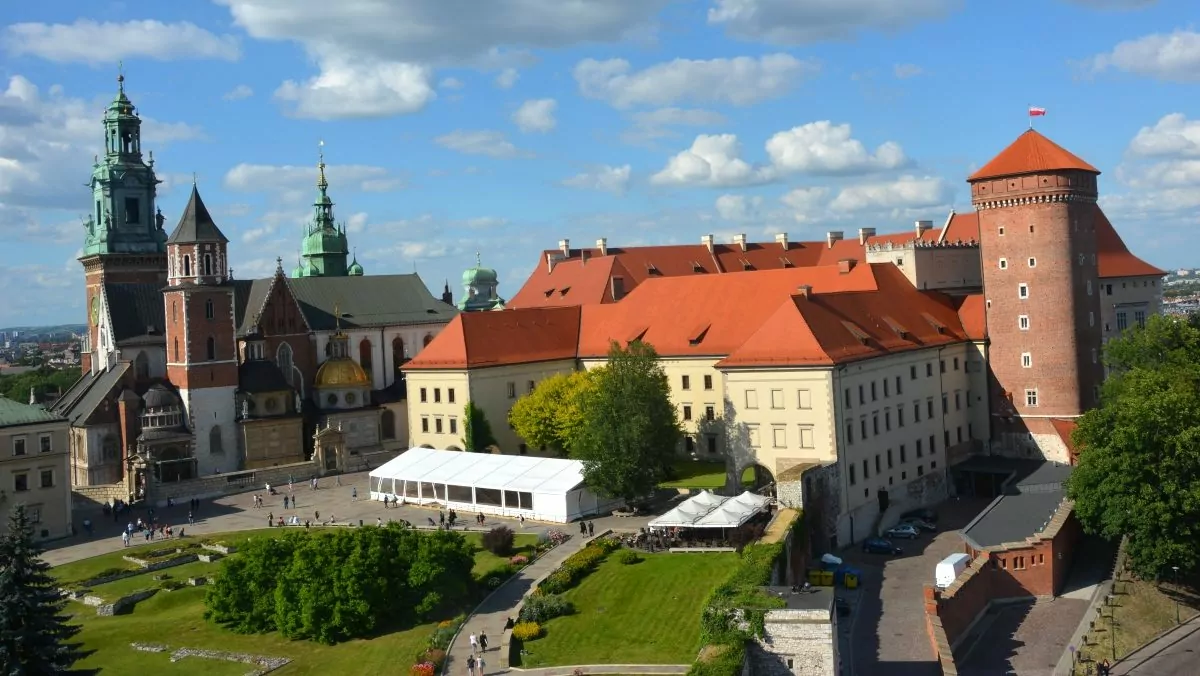








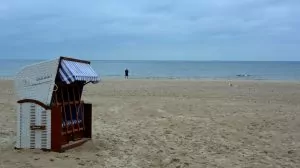

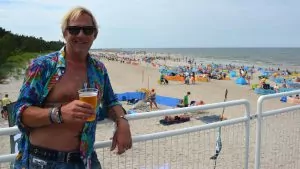







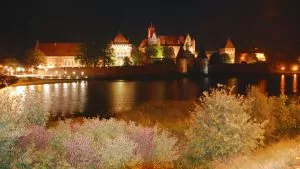





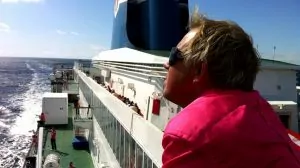
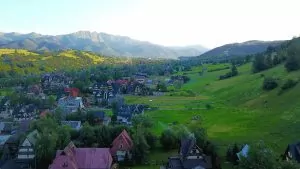














Lena - good for the soul says:
Wow, what a lot of nice things you can see!
Hug Lena
05 July 2017 - 6:24
Helena says:
There are many nice things to see in Poland! 🙂
05 July 2017 - 7:23
Britt-Marie Lundgren says:
It has to be a visit to Krakow, even though it is not at the top of our travel list as our partner has been there.
What food! After such a dinner, I think the "paltcoma" would have struck with full force, although I also like Polish cuisine.
As nice pictures and nice film as usual!
05 July 2017 - 7:09
Helena says:
Krakow is a nice city! The food in Poland is often good, I think, but the portions are large. Sometimes you may need to order a little "smart", like sharing a starter or maybe skip the starter, or order two starters instead of a starter and a main course 😉.
05 July 2017 - 7:26
Mr Nils-Åke Hansson says:
How interesting to see this!
05 July 2017 - 7:57
Helena says:
Poland has a lot to offer, and Krakow is a very nice city!
05 July 2017 - 8:35
Kenneth Risberg says:
So much beauty in Poland and it looks like you don't have to go hungry, duck is delicious!!!
05 July 2017 - 8:06
Helena says:
In a restaurant in Poland, you never have to worry about not being full... 😉.
05 July 2017 - 8:35
Mr Frank Olsen says:
Wawel Cathedral houses one of the largest church bells in the world, weighing 18 tonnes and measuring more than three metres in diameter. You have to climb to the top of the church tower to see it, but it's worth the trip.
The bell is used once a year at Easter time: http://www.krakow-info.com/dzwon4mobile.htm
05 July 2017 - 8:20
Helena says:
Cool and interesting! Thanks for the tip and link! Unfortunately, we did not get up there, but it sounds interesting! Although I don't know if I would make it given that I am afraid of heights ... 😉.
05 July 2017 - 10:36
Matts Torebring says:
It's marvellous! Not even our King Carl Gustav has such fine horses. Extremely nice and reasonably long films that you present (360 degrees I have never been able to see). Thanks for all the tips & Enjoy!
05 July 2017 - 8:25
Helena says:
Glad you like the films Matts! Regarding 360 - what device do you use (desktop, laptop, iPad...?), do you have a PC or Mac and what browser (Explorer, Chrome, Safari...?) do you use?
05 July 2017 - 8:38
Matts Torebring says:
My computer, is a MacBook Pro, and I use Safari. I think it probably needs updating.
05 July 2017 - 19:33
Lennart says:
Poland and Krakow are on the list!
05 July 2017 - 8:29
Mr Frank Olsen says:
Yes Krakow is a great city which we have visited on two occasions.
In Wawel Cathedral hangs one of the largest church bells in the world. It is three metres in diameter and weighs 13 tonnes. You have to climb to the top of the church tower to see it, but it's definitely worth the trip:
https://en.wikipedia.org/wiki/Sigismund_Bell
Another curiosity in Krakow is the trumpeter in the clock tower in the main square. Every full bell hour he plays an interrupted fanfare from the top of the tower. This symbolises a guard who during an enemy attack was shot by an arrow from one of the invaders. Thus, the warning fanfare he was playing was suddenly interrupted in the middle of a note.
05 July 2017 - 8:42
Helena says:
Your comments have come several times, so I've replied to the first part of the comment above 😉 (When you post links, the blog sometimes thinks it's spam and I have to manually approve.) How interesting about the interrupted fanfare! I did not know this!
05 July 2017 - 10:40
Mr Frank Olsen says:
Regarding the comments that came several times; I first tried from the phone (Android) several times but nothing came on the blog ... then I went to the PC and then it worked. But apparently it worked from the phone too, just that it did not appear on the blog ... strange or strange as you say ?
05 July 2017 - 13:40
Mr Frank Olsen says:
And now it works from tel....
05 July 2017 - 13:40
Helena says:
It's probably when there's a link in the comment that the blog thinks it's spam and puts the comment in the spam bin. A bit funny that it's different from PC and phone though... I try to check the spam mail quite often so I see if anything ends up there!
05 July 2017 - 14:18
Ama de casa says:
Looks really beautiful and tasty in that city 🙂 And you are really ahead of your time too. Yes, the end of the film there... December 2017? We haven't got that far yet 😀.
05 July 2017 - 8:45
Helena says:
Haha, oh help ... you are attentive! 😉 I don't understand how it could be like that ... it's just a bit fast ... Asked Peter to change it, but he didn't have it in iMovie, so you have to put up with the fact that it says December ... 😉 .
05 July 2017 - 10:42
Ama de casa says:
Well... Christmas and July aren't that far apart, and then maybe this film is a trailer and the main film is coming in December? 😉
05 July 2017 - 16:37
Daniel@BringBlingToTraveling says:
hello
What are the average prices of the campsites you passed through?
For me, the food in Poland is absolutely delicious.
05 July 2017 - 8:54
Helena says:
The campsites in Poland have cost around 170 SEK per day including electricity. Sometimes a little more expensive, sometimes a little cheaper. Czech Republic was probably about the same, maybe slightly cheaper.
05 July 2017 - 10:44
Anette Åhnbrink says:
Krakow seems definitely worth seeing, how can you do it all? Guess you're going back there in December to get a prize, or...?
It's good that you get to eat well and a little in the glasses too, it's needed as you're travelling around... Roll quietly/Anette
05 July 2017 - 9:26
Helena says:
I do not understand how we happened to write December (too much good wine maybe haha). It should say July ... but now it's too late to change because Peter has removed the film from iMovie ... Krakow is worth seeing! 🙂
05 July 2017 - 10:47
Goatfish says:
Poland is on my wish list for a long time 😀 will see when it can happen.
Just got back from Wales, which was a great experience.
Sunny hugs from a future Power Big Meet Lidköping!
05 July 2017 - 9:51
Helena says:
Understand that you had a great time in Wales! Looking forward to hearing more about it!!! Have fun today!
05 July 2017 - 10:48
Mr Steve says:
There are so many amazing things to see and experience just "a stone's throw" away.
Cool with 360 images.
05 July 2017 - 10:37
Helena says:
Yes indeed! Glad you appreciate the 369 images!
05 July 2017 - 10:48
Denandraresan.com says:
Oops, we just missed each other! Just left Kraków a few days ago. I've been to Kraków a couple of times before but most recently as a teenager. This time to show the family the city so it was a rather different trip now. Did you see the dragon spraying fire? 🙂 My blog is quite behind with posts but now the rest of the family has gone on a short hike so I will take my time now. Where do you go after Kraków?
05 July 2017 - 12:24
Helena says:
But oh is it true? I have tried to keep track of whether we could meet somewhere, but it is not easy when both we and you are travelling around ... 😉 We have just left Krakow and headed east. Our plan is to head towards the national park in the east and then to the Mazuri lakes, or whatever they are called? Have you been there? By the way, we missed the fire-breathing dragon ... where would we have seen it?
05 July 2017 - 13:17
Denandraresan.com says:
It is right by the wavel! It's the dragon that was killed and so the castle was built right there on the dragon's lair. It is not really an adult thing... it is like a tunnel you go through and then on the other side there is the dragon fixed in bronze. he sprays fire every 20 minutes..there are a lot of children standing around waiting for when the fire comes 🙂 . will have a picture on my post about it 🙂 .
The Mazury lakes are supposed to be so clear that you can dive in them... I've heard. Have a good trip!
05 July 2017 - 14:56
Helena says:
Ah ok, yes we missed that! The lakes are exciting - we report of course! 🙂
05 July 2017 - 21:05
Husis blog says:
Krakow will probably have to be added to the current travel destinations. You and many others have made this list so long that I don't know how the owners can keep up...?
The horsebox was one of the most beautiful things the owners have seen. Even the male owner could have taken a ride.
05 July 2017 - 18:17
Helena says:
Yes, our list of places we want to see is also long... but I think I'd rather have a list that I don't have time for, than not dream of anything 😉 Yes, the horses are incredibly beautiful!
05 July 2017 - 21:00
Ditte says:
Krakow is a fantastic city and very beautiful and well preserved from the war as it was never bombed.
There is so much to see and experience here and so much history and culture.
We were there for a few days in March and would love to come back. Recognise your pictures, though we ate in other places. We lived perfectly in the old town and with walking distance to everything. And if you are in the area, the salt mine and Auschwitz are recommended.
So I understand that you had great days here, even if you have been here before.
Stay safe on your journey.
05 July 2017 - 20:39
Helena says:
Agreed! We have been to the salt mine before and I have also visited Auschwitz. Therefore, we skipped it on this trip, but I agree that it is worth seeing!
05 July 2017 - 21:02
BP says:
What nice pictures and great film from Krakow! Peter even captured the aeroplanes. It was well done!!!
Love the Clothes Hall and the absolutely magnificent cathedral. Yes, not to mention the food. In Poland we also often go for duck, something you would never cook yourself (at least not us) and which would ruin the budget if you ate that portion in a restaurant.
05 July 2017 - 20:42
Helena says:
Glad you like the pictures and the film! 🙂 We have tried to cook duck once ourselves, but it was too dry ... In Poland / Czech Republic / Hungary they seem to know how to do it 😉 And the prices are absolutely humane! The duck was probably the most expensive on the whole menu, and that meant that it cost about 100 SEK.
05 July 2017 - 21:04
Linda says:
It's clear that we have a lot of beautiful things left to see....
What nice pictures and what good food!
Thanks for the insight into your journey!
Linda
05 July 2017 - 23:14
LinizTravel says:
Love Krakow! So cosy!!! Hugs
06 July 2017 - 8:45
Maria's Memoirs says:
Oh, beautiful Krakow! I remember the main square so well!
14 July 2017 - 12:47
Eva on a rucksack says:
Always as inspiring and wonderfully written! Now I get really excited for our Krakow trip! Good tips there with the food, will try to get the family not to eat themselves full on the starter 🙂 .
18 October 2018 - 7:51
Snows says:
We are going to Krakow this summer so it was interesting to read about your trip there and your tips.
05 March 2019 - 21:00